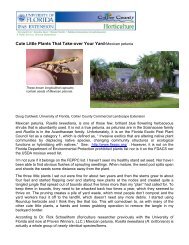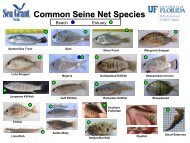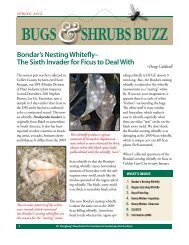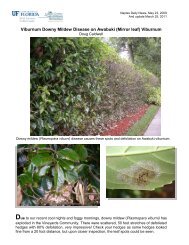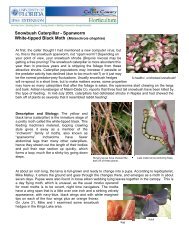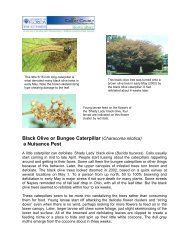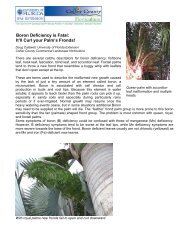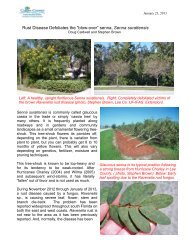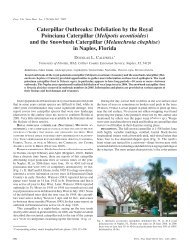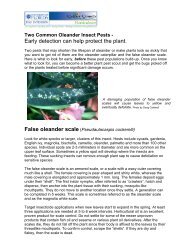Clerodendrum Incisum Macrosiphon - Collier County Extension ...
Clerodendrum Incisum Macrosiphon - Collier County Extension ...
Clerodendrum Incisum Macrosiphon - Collier County Extension ...
You also want an ePaper? Increase the reach of your titles
YUMPU automatically turns print PDFs into web optimized ePapers that Google loves.
Naples Daily News August 16, 2008<br />
<strong>Clerodendrum</strong> ‘Musical Note’, a Cheery Filler in the Shrub Bed<br />
Doug Caldwell, Commercial Landscape Horticulture<br />
<strong>Clerodendrum</strong> incisum ‘<strong>Macrosiphon</strong>’ sometimes referred to as ‘Musical Note’ strikes a<br />
winning chord in the small shrub orchestra. This plant is not one of the well known species<br />
in the large <strong>Clerodendrum</strong> group. And unusual for a <strong>Clerodendrum</strong>, it makes my “short<br />
shrub” list at 3 to 5 feet tall and 4 to 5 feet wide; it needs little pruning. This is a repeat<br />
bloomer and produces flowers almost monthly, if left unsheared.<br />
As with many of the clerodendrum species, the flower has outrageously long stamens that<br />
add to the delicate interest as they extend outward about 1.5 inches beyond the flower’s<br />
merged petals or corolla. The four-inch long, trumpet shaped blossom expands amazingly<br />
from a little nubbin and briefly resembles a soprano-range, eighth note. As the flower<br />
stretches, the club portion or end of the “note” splits and flattens into a corolla resembling a<br />
small white butterfly. The flower clusters start in a series of about 5 to 10 buds and with<br />
several buds on a twig tip, this plant puts on a “WOW” show! Watching these flowers<br />
develop is much like watching a butterfly proboscis uncoil or one of those curly party favors<br />
(in slow motion) people blow and toot to annoy others at New Years events.<br />
Unfortunately, the flowers, which don’t have a fragrance, are short lived, maybe lasting for<br />
two days. If it rains they tend to drop and it looks like a drift of snow beneath the plant. My<br />
plants start flowering around the fourth of July and have repeating bursts on a monthly<br />
basis into November or so. The lanceolate leaves don’t get a high rating as they are a dull
Naples Daily News August 16, 2008<br />
green. They range from two to four inches long, are variable in shape some have smooth<br />
entire margins, other leaves have scattered 1/8 to 3/8 inch long, seemingly random<br />
serrations.<br />
Maybe because the two shrubs I have are in mostly sandy soil, they lose their leaves<br />
during the winter and look absolutely ugly. This species does better in semi-shade; avoid<br />
full sun exposure. I persuaded Michelle Rowland, Landscape Superintendent at Grey<br />
Oaks, to try this plant. There is a planting to the right of their pool entry area Their plants<br />
don’t defoliate in the winter! I imagine there is some potting mix in that bed that improves<br />
the situation. I label this species semi-deciduous, defoliation is variable depending on how<br />
much stress and cold it is exposed to. Michelle gets favorable remarks about the plant.<br />
They plants are cut back moderately in March-April or so and they quickly fill in. One<br />
maintenance issue is that the flower petals don’t drop completely, so cleaning the old<br />
petals off the shrub is something to expect. The maintenance folks at Grey Oaks do some<br />
light touch up pruning during the summer as the plants become a little floppy.<br />
Michelle remarked that ‘Musical Note’ tolerates dry spells once it is established. If sooty<br />
mold develops, look for aphid<br />
infestations on the new growth<br />
and use a horticultural soap or<br />
contact insecticide labeled for<br />
landscape plant use.<br />
Try adding this intriguing plant<br />
from Nigeria to your shrub bed<br />
areas, but you may not want to<br />
place it in the front row, in case it<br />
drops its leaves during the winter.<br />
This unique flowering plant is a<br />
real attention getter. Also visit,<br />
http://toptropicals.com/cgibin/garden_catalog/cat.cgi<br />
for<br />
lots of pictures and information<br />
on tropical flowering plants.<br />
Doug Caldwell, Ph.D., is the commercial landscape horticulture extension agent and landscape<br />
entomologist with the University of Florida <strong>Collier</strong> <strong>County</strong> <strong>Extension</strong> Service. The Cooperative<br />
<strong>Extension</strong> Service is an off-campus branch of the University of Florida, Institute of the Food and<br />
Agricultural Sciences and a department of the Public Services Division of <strong>Collier</strong> <strong>County</strong><br />
government. E-mail dougbug@ufl.edu ; phone, 353-4244 x203. <strong>Extension</strong> programs are open to all<br />
persons without regard to race, color, creed, sex, handicap or national origin. For updates on<br />
Southwest Florida Horticulture visit: http://collier.ifas.ufl.edu




